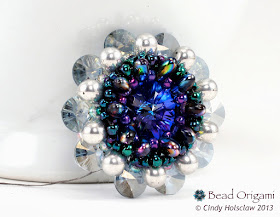Beaded Caffeine Prototypes, Circa 2007
During a recent studio re-organization, I found some of the first caffeine molecules that I had ever beaded! These date back to sometime in 2007, before I started writing beading patterns.
As you can see, I had played around with the idea of using round beads to stabilize the rings of the molecule. The atoms were represented by an 8° seed bead, with the bonds represented by smaller seed beads. However, even with the round "core" beads, these were too floppy for my taste, and rather, well, inelegant.
(I was also into blue colorways, big time)
Snowflake-Style Caffeine Prototype
The key to the finished beaded caffeine molecule was realizing that it needed multiple, redundant thread paths, and multiple layers of beadwork. My snowflakes design was what led me to this idea, as I blogged about last December.
Using the snowflakes design as a guide, I whipped up this prototype using the geometry of a caffeine molecule:
As you can see, it looks much more like the final design, but with some snowflakes elements such as the 15° seed beads in the centers of the rings. Each atom branching off of the rings is slightly different, as I was experimenting with different ways of beading these branched atoms each time. By the time I finished the last branch, I came to a conclusion about the style that I wanted to use.
Finished Coffee Molecules
The finished design is a bit more streamlined, and works with several different kinds of flat molecules, not just caffeine!
The caveat to this style is that most molecules are much more dimensional, and therefore much more challenging to render accurately in beadwork. However, that's a subject for another day...
Do you keep the prototypes to your beading designs? Have you ever found a beading design many years later? Drop me a line in the comments and let me know!




















































